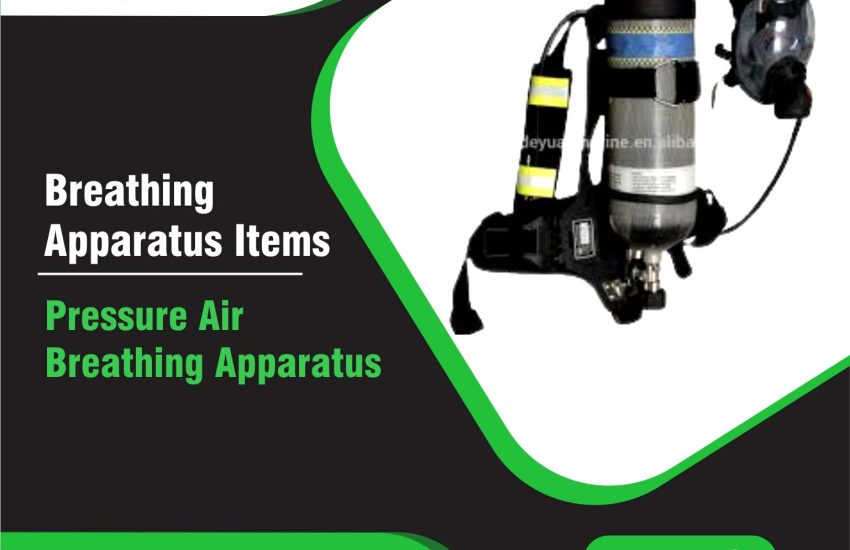A Pressure Air Breathing Apparatus (PABA) serves as a critical safety device, supplying breathable air in environments where air quality is compromised. Workers in industries like firefighting, rescue operations, mining, and chemical plants rely on these devices, as they may be exposed to toxic gases, smoke, or oxygen-deficient conditions. This article delves into the specifications, features, and benefits of a Pressure Air Breathing Apparatus, ensuring that workers have access to the safest and most effective respiratory protection.
What is a Pressure Air Breathing Apparatus (PABA)?
A Pressure Air Breathing Apparatus is designed to supply breathable air to users working in hazardous conditions. It typically includes a high-pressure air cylinder, regulator, mask, and other components that control the flow of oxygen to the wearer. The apparatus ensures protection from inhaling harmful substances such as smoke, gases, or dust, while maintaining a constant supply of breathable air.
Specifications of Pressure Air Breathing Apparatus
To ensure safety and effectiveness, the Pressure Air Breathing Apparatus has several specifications that comply with international safety standards. These include:
1. Cylinder Pressure
- Cylinder pressure typically ranges from 200 to 300 bar, which is sufficient to provide a steady air flow under challenging conditions. The high-pressure cylinders are constructed from materials like aluminum, carbon fiber, or steel to ensure durability.
2. Cylinder Capacity
- The capacity of the cylinder determines the duration of air supply. Standard cylinder sizes range from 6 liters to 12 liters. Larger cylinders offer longer operational durations, making them ideal for extended operations or hazardous tasks.
3. Duration of Use
- A Pressure Air Breathing Apparatus can typically operate for 30 minutes to 2 hours, depending on the cylinder size and air consumption rate. The exact duration depends on various factors like the wearer’s breathing rate and the airflow rate of the system.
4. Mask and Facepiece
- The mask or facepiece covers the user’s nose and mouth, or in some models, the entire face. Made from silicone or rubber, the facepiece ensures a secure, comfortable fit. It is also equipped with high-efficiency filters to block harmful particles and gases.
5. Regulator
- The regulator controls the airflow from the air cylinder to the user, maintaining a constant and safe pressure. Low-pressure regulators are commonly used to ensure efficient air distribution.
6. Alarm Systems
- Advanced PABA models include low-pressure alarms that warn the wearer when the air supply is running low. This feature helps ensure timely evacuation from hazardous areas before the air supply runs out.
7. Materials and Durability
- Manufacturers typically make the cylinder from lightweight aluminum, carbon fiber, or steel to enhance durability and resistance to wear. They often design the facepiece and straps from silicone or rubber, ensuring comfort without compromising safety.
8. Weight
- The weight of a typical Pressure Air Breathing Apparatus ranges between 6 to 15 kg, depending on cylinder size and overall design. Designers make the apparatus light enough for the wearer to move freely while ensuring full protection.
9. Temperature Range
- Engineers design PABAs to work effectively in extreme temperatures, typically ranging from -30°C to +60°C, ensuring reliable performance in various environmental conditions.
10. Approval and Standards
- Certified Pressure Air Breathing Apparatus meet international standards such as NIOSH, NFPA 1981, and EN 137. These certifications guarantee that the apparatus offers optimal protection for users in hazardous environments.
Types of Pressure Air Breathing Apparatus
There are several types of Pressure Air Breathing Apparatus, each designed for specific environments and tasks. These include:
1. Self-Contained Breathing Apparatus (SCBA)
- The SCBA is the most common type of PABA, used by firefighters, rescue teams, and industrial workers. It includes a tank, face mask, regulator, and harness, providing independent air supply for the wearer.
2. Escape Breathing Apparatus
- Designed for emergency situations, the escape breathing apparatus provides a limited air supply to help the wearer safely exit hazardous environments. It typically offers 10 to 15 minutes of air, sufficient for escape.
3. Open-Circuit Breathing Apparatus
- In an open-circuit system, the apparatus supplies air to the wearer and releases it into the atmosphere after use. Firefighters and rescue teams commonly use this system.
4. Closed-Circuit Breathing Apparatus
- A closed-circuit system recycles the wearer’s exhaled air by removing carbon dioxide and replenishing it with oxygen. This system is ideal for confined spaces, offering extended use while maintaining a continuous supply of breathable air.
Key Features and Benefits of Pressure Air Breathing Apparatus
1. Protection Against Hazardous Gases
- In an open-circuit system, the apparatus supplies air to the wearer and releases it into the atmosphere after use. Firefighting and rescue operations commonly use this system.”
2. Reliability and Durability
- Engineers design PABAs to withstand harsh conditions, ensuring long-term use without compromising safety.The materials used are durable, ensuring the apparatus performs reliably even in extreme environments.
3. Ease of Use
- PABA systems are designed to be user-friendly, with adjustable straps and simple controls. This makes it easy for workers to quickly put on and adjust the equipment in emergency situations.
4. Comfortable Fit
- Designers ergonomically design the facepiece and harness for comfort, allowing the wearer to work for extended periods without discomfort or fatigue.
5. Compliance with International Standards
- A certified PABA complies with international safety standards such as NIOSH, NFPA, and EN 137, providing workers with confidence in the equipment’s effectiveness and reliability.
Conclusion
Workers in hazardous environments, where air quality is compromised, rely on a Pressure Air Breathing Apparatus for protection. With durable construction, reliable air supply, and user-friendly design, PABA systems provide vital protection in emergency and high-risk situations. By understanding the specifications of PABAs, including cylinder pressure, capacity, alarm systems, and regulation, you can select the right equipment for your specific needs.


